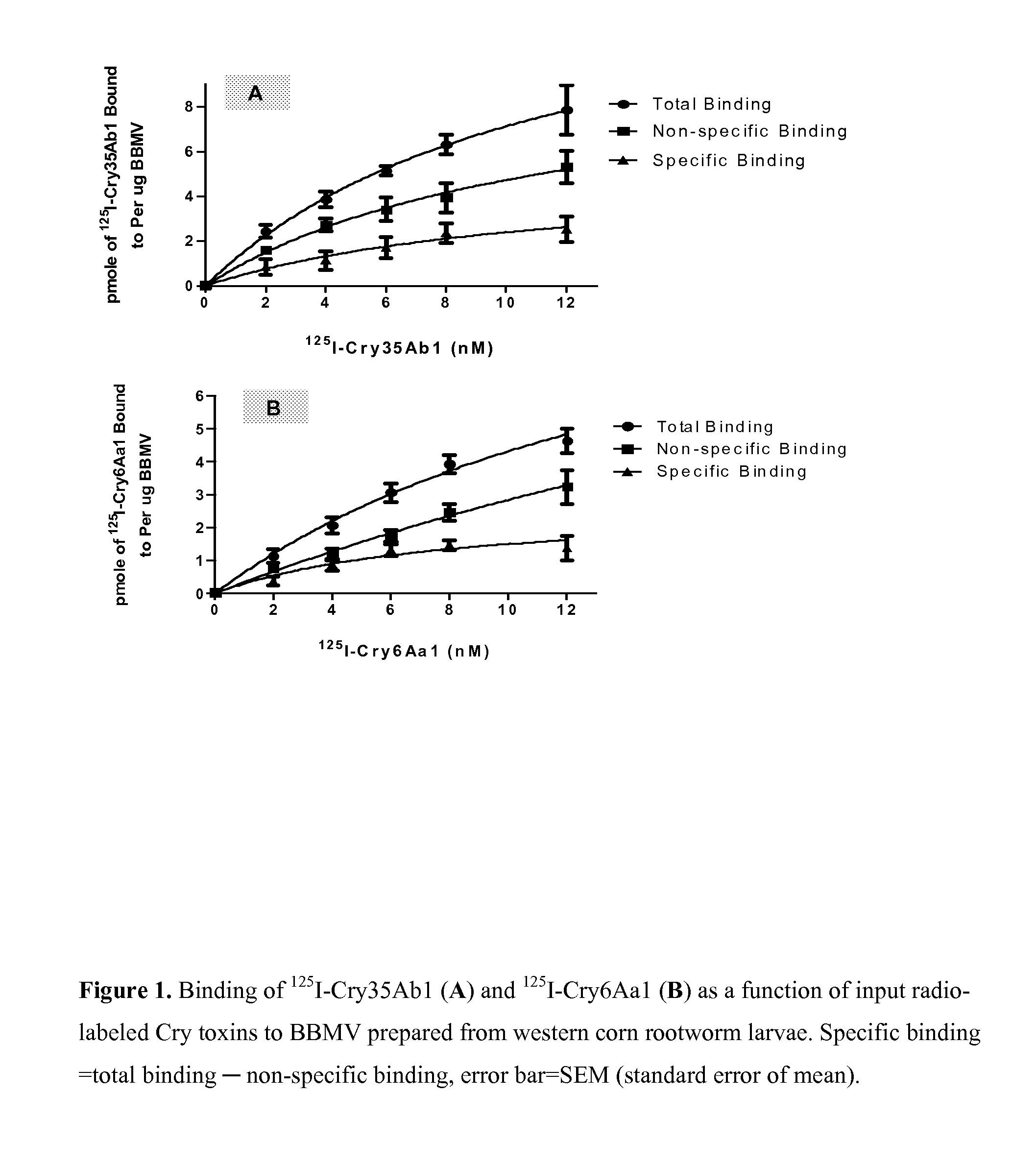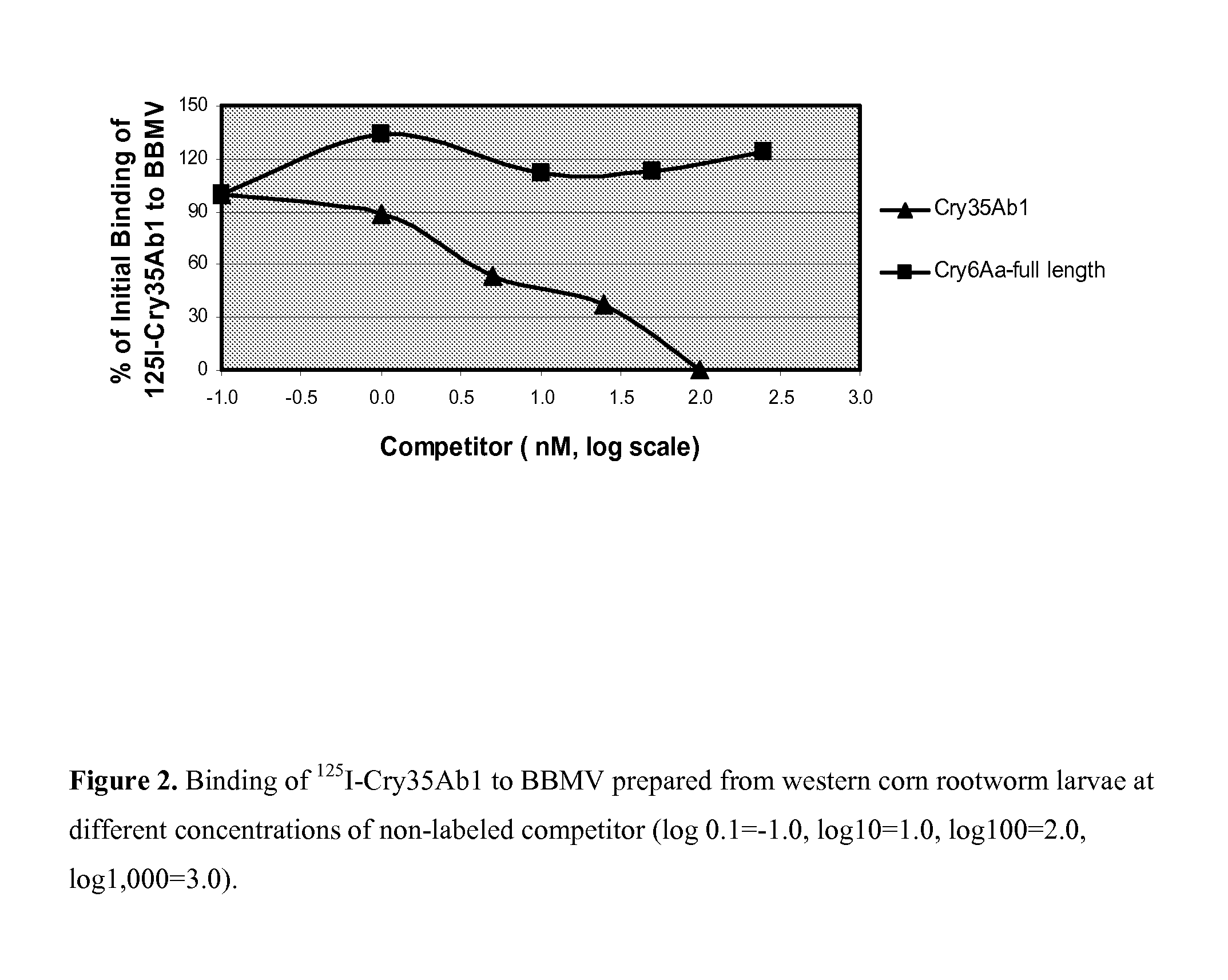COMBINATIONS INCLUDING Cry34Ab/35Ab AND Cry6Aa PROTEINS TO PREVENT DEVELOPMENT OF RESISTANCE IN CORN ROOTWORMS (DIABROTICA SPP.)
a technology of corn rootworms and proteins, which is applied in the field of conjugations including cry34ab/35ab and cry6aa proteins to prevent the development of resistance in corn rootworms (diabrotica spp.), can solve the problems of affecting the survival of corn rootworms, and affecting the growth of corn rootworms. , to achieve the effect of preventing the development of resistan
- Summary
- Abstract
- Description
- Claims
- Application Information
AI Technical Summary
Benefits of technology
Problems solved by technology
Method used
Image
Examples
example 1
Construction of Expression Plasmids Encoding Cry34Ab1, Cry35Ab1, and Cry6Aa1 Full-Length Toxins
[0089]Standard cloning methods were used in the construction of Pseudomonas fluorescens (Pf) expression plasmids engineered to produce a full-length Cry34Ab1, Cry35Ab1, and Cry6Aa1 Cry proteins, respectively. Restriction endonucleases from New England BioLabs (NEB; Ipswich, Mass.) were used for DNA digestion and T4 DNA Ligase from Invitrogen was used for DNA ligation. Plasmid preparations were performed using the Plasmid Mini kit (Qiagen, Valencia, Calif.), following the instructions of the supplier. DNA fragments were purified using the Millipore Ultrafree®-DA cartridge (Billerica, Mass.) after agarose Tris-acetate gel electrophoresis. The basic cloning strategy entailed subcloning the coding sequences (CDS) of a full-length of these Cry proteins into pMYC1803 for Cry34Ab1 and Cry35Ab1, and into pDOW1169 for Cry6Aa1 at SpeI and XhoI (or SalI that is compatible with XhoI) restriction sites...
example 2
Growth and Expression
[0091]Growth and expression analysis in shake flasks production of Cry34Ab1, Cry35Ab1, and Cry6Aa1 toxins for characterization including Bt receptor binding and insect bioassay was accomplished by shake-flask-grown P. fluorescens strains harboring expression constructs (e.g. clone pMYC2593 for Cry34Ab1, pMYC3122 for Cry35Ab1, and pDAB102018 for Cry6Aa1). Seed cultures for Cry34Ab1 and Cry35Ab1 grown in P. fluorescens medium overnight supplemented with 20 μg / ml tetracycline were used to inoculate 200 mL of the same medium with 20 μg / ml tetracycline. However, the seed culture for Cry6Aa1 was grown in M9 minimal broth overnight and was used to inoculate 200 mL of the P. fluorescens medium without antibiotic. Expressions of Cry34Ab1, Cry35Ab1, and Cry6Aa1 toxins via the Ptac promoter were induced by addition of isopropyl-β-D-1-thiogalactopyranoside (IPTG) after an initial incubation of 24 hours at 28-30° C. with shaking at 300 rpm. Cultures were sampled at the time ...
example 3
Cell Fractionation and SDS-PAGE Analysis of Shake Flask Samples
[0092]At each sampling time, the cell density of the samples was adjusted to OD600=20 and 1-mL aliquots are centrifuged at 14,000×g for five minutes. The cell pellets were frozen at −80° C. Soluble and insoluble fractions from frozen cell pellet samples were generated using EasyLyse™ Bacterial Protein Extraction Solution (EPICENTRE® Biotechnologies, Madison, Wis.). Each cell pellet was resuspended in 1 mL EasyLyse™ solution and further diluted 1:4 in lysis buffer and incubated with shaking at room temperature for 30 minutes. The lysate was centrifuged at 14,000 rpm for 20 minutes at 4° C. and the supernatant was recovered as the soluble fraction. The pellet (insoluble fraction) was then resuspended in an equal volume of phosphate buffered saline (PBS; 11.9 mM Na2HPO4, 137 mM NaCl, 2.7 mM KCl, pH7.4). Samples were mixed at 3:1 with 4× Laemmli sample buffer containing β-mercaptoethanol and boiled for 5 minutes prior to loa...
PUM
| Property | Measurement | Unit |
|---|---|---|
| pH | aaaaa | aaaaa |
| pH | aaaaa | aaaaa |
| molecular mass | aaaaa | aaaaa |
Abstract
Description
Claims
Application Information
 Login to View More
Login to View More - R&D
- Intellectual Property
- Life Sciences
- Materials
- Tech Scout
- Unparalleled Data Quality
- Higher Quality Content
- 60% Fewer Hallucinations
Browse by: Latest US Patents, China's latest patents, Technical Efficacy Thesaurus, Application Domain, Technology Topic, Popular Technical Reports.
© 2025 PatSnap. All rights reserved.Legal|Privacy policy|Modern Slavery Act Transparency Statement|Sitemap|About US| Contact US: help@patsnap.com


